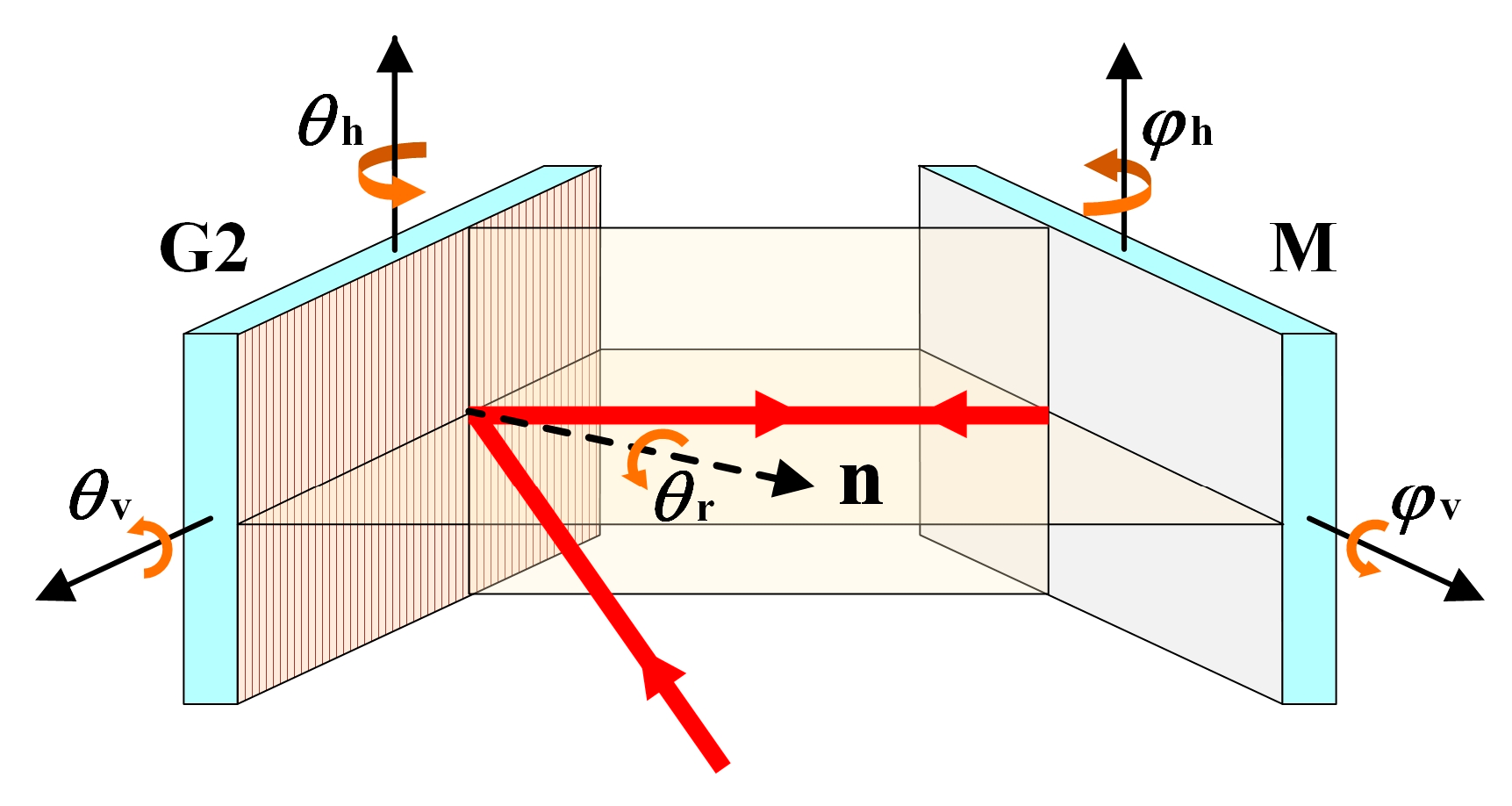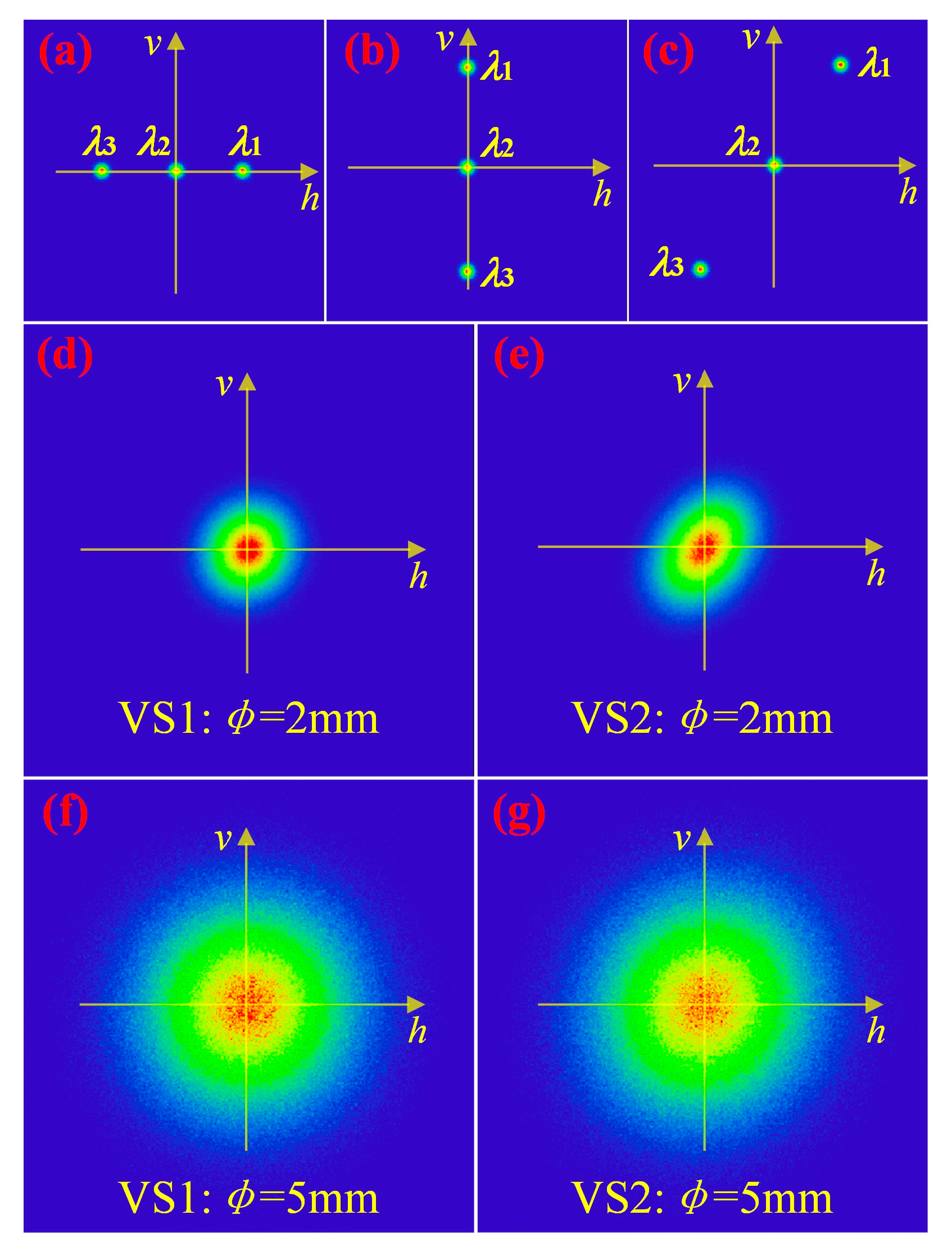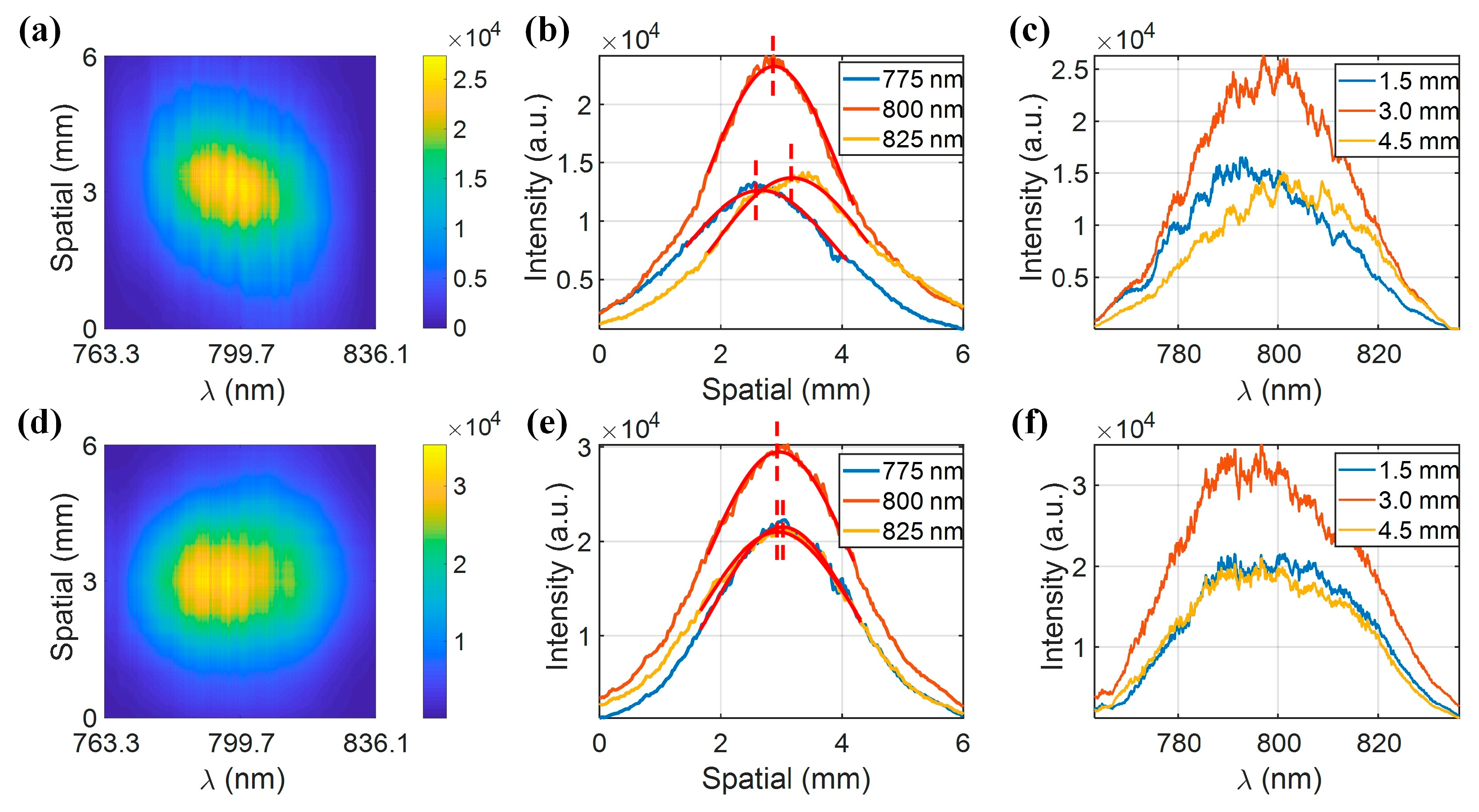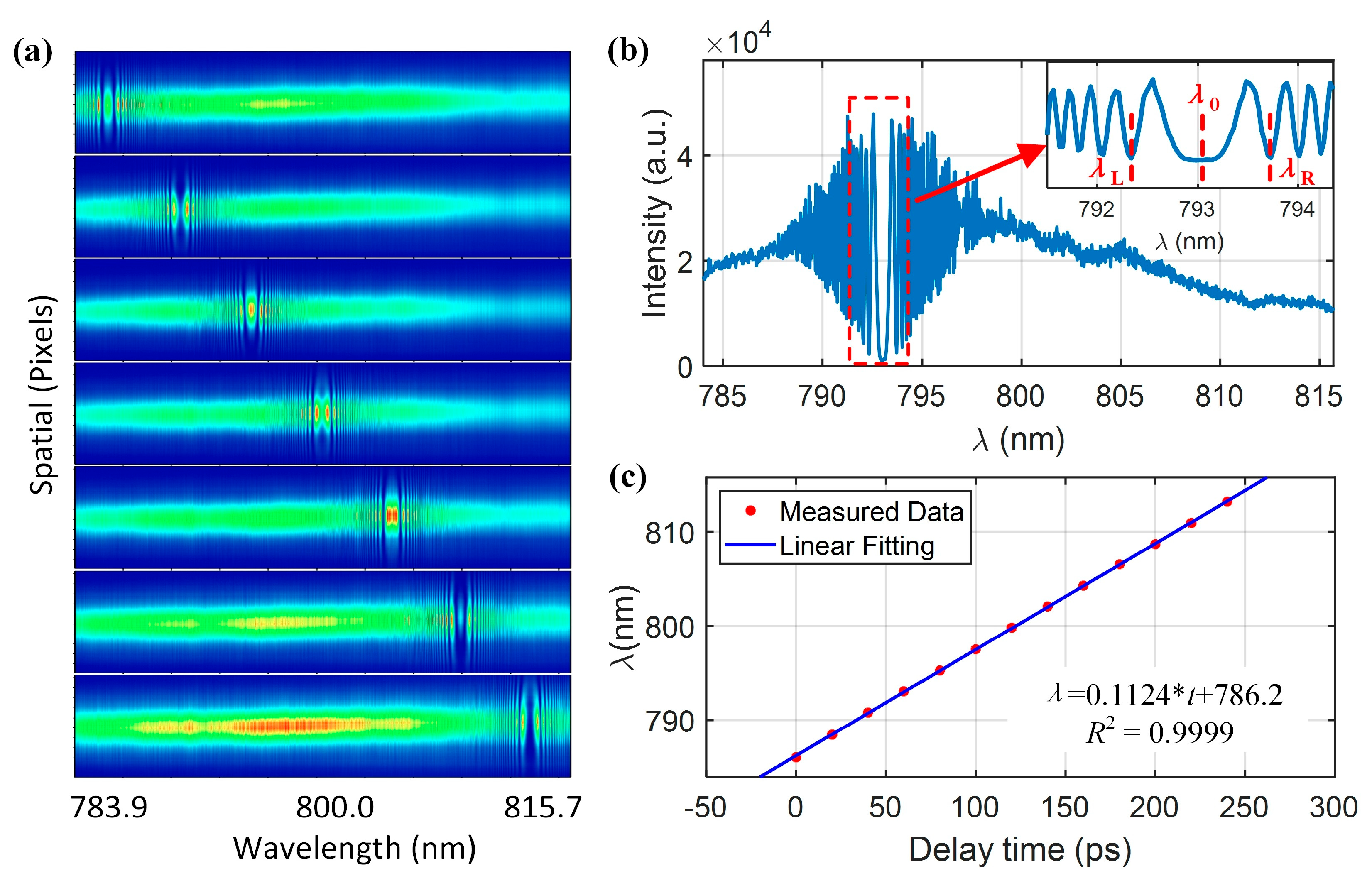Investigation of Spatial Chirp Induced by Misalignments in a Parallel Grating Pair Pulse Stretcher
Abstract
:1. Introduction
2. Design of Chirped Pulse Stretcher
3. Spatial Chirp Induced by the Misalignments and its Adjustment
3.1. Misalignments of the Gratings and Mirrors in the Stretcher
3.2. Spatial Chirp Analysis with the Ray Tracing Simulation Method
3.3. Adjustments Method to Calibrate the Misalignments
4. Experimental results
4.1. Spatial Chirp Measurement of the Stretched Pulse
4.2. Temporal Chirp Measurement of the Stretched Pulse
5. Conclusions
Author Contributions
Funding
Acknowledgments
Conflicts of Interest
References
- Geindre, J.P.; Audebert, P.; Rebibo, S.; Gauthier, J.C. Single-shot spectral interferometry with chirped pulses. Opt. Lett. 2001, 26, 1612–1614. [Google Scholar] [CrossRef]
- McGrane, S.D.; Moore, D.S.; Funk, D.J.; Rabie, R.L. Spectrally modified chirped pulse generation of sustained shock waves. Appl. Phys. Lett. 2002, 80, 3919–3921. [Google Scholar] [CrossRef]
- Chien, C.Y.; Fontaine, B.L.; Desparois, A.; Jiang, Z.; Johnston, T.W.; Kieffer, J.C.; Pepin, H.; Vidal, F. Single-shot chirped-pulse spectral interferometry used to measure the femtosecond ionization dynamics of air. Opt. Lett. 2000, 25, 578–580. [Google Scholar] [CrossRef] [PubMed]
- Rebibo, S.; Geindre, J.P.; Audebert, P.; Grillon, G.; Chambaret, J.P.; Gauthier, J.C. Single-shot spectral interferometry of femtosecond laser-produced plasmas. Laser Part. Beams 2001, 19, 67–73. [Google Scholar] [CrossRef]
- Zheng, S.; Lin, Q.; Cai, Y.; Zeng, X.; Li, Y.; Xu, S.; Li, J.; Fan, D. Improved common-path spectral interferometer for single-shot terahertz detection. Photonics Res. 2018, 6, 177. [Google Scholar] [CrossRef]
- Yellampalle, B.; Kim, K.Y.; Rodriguez, G.; Glownia, J.H.; Taylor, A.J. Details of electro-optic terahertz detection with a chirped probe pulse. Opt. Express 2007, 15, 1376–1383. [Google Scholar] [CrossRef]
- Shkrob, I.A.; Oulianov, D.A.; Crowell, R.A.; Pommeret, S. Frequency-domain “single-shot” ultrafast transient absorption spectroscopy using chirped laser pulses. J. Appl. Phys. 2004, 96, 25–33. [Google Scholar] [CrossRef] [Green Version]
- Brown, K.E.; Bolme, C.A.; McGrane, S.D.; Moore, D.S. Ultrafast shock-induced chemistry in carbon disulfide probed with dynamic ellipsometry and transient absorption spectroscopy. J. Appl. Phys. 2015, 117, 085903. [Google Scholar] [CrossRef]
- Shikne, R.; Yoneda, H. Ultrafast ellipsometric pump-probe diagnostic of liquid metal surface with chirped continuum probe pulses. Opt. Express 2015, 23, 20933–20940. [Google Scholar] [CrossRef]
- Treacy, E. Optical pulse compression with diffraction gratings. IEEE J. Quantum Electron. 1969, 5, 454–458. [Google Scholar] [CrossRef]
- Martinez, O. 3000 times grating compressor with positive group velocity dispersion: Application to fiber compensation in 1.3-1.6 µm region. IEEE J. Quantum Electron. 1987, 23, 59–64. [Google Scholar]
- Martinez, O.E.; Gordon, J.P.; Fork, R.L. Negative group-velocity dispersion using refraction. J. Opt. Soc. Am. A 1984, 1, 1003–1006. [Google Scholar]
- Galvanauskas, A. Mode-scalable fiber-based chirped pulse amplification systems. IEEE. J. Sel. Top. Quantum Electron. 2001, 7, 504–517. [Google Scholar] [CrossRef]
- Zhang, Z.; Yagi, T. Evaluation of dispersion in a misaligned grating pair pulse compressor. J. Appl. Phys. 1995, 77, 937–939. [Google Scholar] [CrossRef]
- Zhang, Z.; Yagi, T.; Arisawa, T. Ray-tracing model for stretcher dispersion calculation. Appl. Opt. 1997, 36, 3393–3399. [Google Scholar] [CrossRef]
- Zhang, Z.; Harayama, S.; Yagi, T.; Arisawa, T. Vertical chirp in grating pair stretcher and compressor. Appl. Phys. Lett. 1995, 67, 176–178. [Google Scholar] [CrossRef]
- Liu, W.; Zhu, Q.; Feng, G.; Jiang, D.; Zuo, Y.; Wang, X.; Chen, J. Study of dispersions on grating-pair compressor in the case of unparallel grooves. Optik 2006, 117, 236–239. [Google Scholar]
- Daiya, D.; Patidar, R.K.; Sharma, J.; Joshi, A.S.; Naik, P.A.; Gupta, P.D. Optical design and studies of a tiled single grating pulse compressor for enhanced parametric space and compensation of tiling errors. Opt. Commun. 2017, 389, 165–169. [Google Scholar] [CrossRef]
- Chen, Y.; Wang, C.; Zhang, Z.; Yang, X.; Xu, Y.; Leng, Y.; Xu, Z. Investigation of spatio-temporal stretching in a duplex grating compressor. Opt. Express 2019, 27, 31667–31675. [Google Scholar] [CrossRef]
- Gu, X.; Akturk, S.; Trebino, R. Spatial chirp in ultrafast optics. Opt. Commun. 2004, 242, 599–604. [Google Scholar] [CrossRef]
- Osvay, K.; Ross, I.N. On a pulse compressor with gratings having arbitrary orientation. Opt. Commun. 1994, 105, 271–278. [Google Scholar] [CrossRef]
- Osvay, K.; Kovacs, A.P.; Heiner, Z.; Kurdi, G.; Klebniczki, J.; Csatari, M. Angular dispersion and temporal change of femtosecond pulses from misaligned pulse compressors. IEEE. J. Sel. Top. Quantum Electron. 2004, 10, 213–220. [Google Scholar] [CrossRef]
- Guardalben, M.J. Littrow angle method to remove alignment errors in grating pulse compressors. Appl. Opt. 2008, 47, 4959–4964. [Google Scholar] [CrossRef] [PubMed]
- Lai, M.; Lai, S.T.; Swinger, C. Single-grating laser pulse stretcher and compressor. Appl. Opt. 1994, 33, 6985–6987. [Google Scholar] [CrossRef] [PubMed]
- Chauhan, V.; Bowlan, P.; Cohen, J.; Trebino, R. Single-diffraction-grating and grism pulse compressors. J. Opt. Soc. Am. B 2010, 27, 619–624. [Google Scholar] [CrossRef]
- Fan, W.; Zhu, B.; Wu, Y.; Qian, F.; Shui, M.; Du, S.; Zhang, B.; Wu, Y.; Xin, J.; Zhao, Z.; et al. Measurement of the chirp characteristics of linearly chirped pulses by a frequency domain interference method. Opt. Express 2013, 21, 13062–13067. [Google Scholar] [CrossRef]








| Misalignments | Off-Axis Deviation (mm) of λ2 (800 nm) | Line Dispersion (mm) Between λ1 (775 nm) and λ3 (825 nm) | |||
|---|---|---|---|---|---|
| Horizontal Direction | Vertical Direction | Horizontal Direction | Vertical Direction | ||
| Grating | θh = −0.2° | 64.07 | 0 | −0.57 | 0 |
| θv = −0.1° | 0 | 27.55 | 0 | 0 | |
| θr = 0.1° | 0 | −15.20 | 0 | 1.17 | |
| Mirror | φh = −0.424° | −64.28 | 0 | 1.56 | 0 |
| φv = −0.078° | 0 | −12.34 | 0 | 0.18 | |
| The five misalignments exist simultaneously | −0.05 | −0.02 | 0.94 | 1.35 | |
© 2020 by the authors. Licensee MDPI, Basel, Switzerland. This article is an open access article distributed under the terms and conditions of the Creative Commons Attribution (CC BY) license (http://creativecommons.org/licenses/by/4.0/).
Share and Cite
Zhong, Z.; Gong, W.; Jiang, H.; Gu, H.; Chen, X.; Liu, S. Investigation of Spatial Chirp Induced by Misalignments in a Parallel Grating Pair Pulse Stretcher. Appl. Sci. 2020, 10, 1584. https://doi.org/10.3390/app10051584
Zhong Z, Gong W, Jiang H, Gu H, Chen X, Liu S. Investigation of Spatial Chirp Induced by Misalignments in a Parallel Grating Pair Pulse Stretcher. Applied Sciences. 2020; 10(5):1584. https://doi.org/10.3390/app10051584
Chicago/Turabian StyleZhong, Zhicheng, Wenqi Gong, Hao Jiang, Honggang Gu, Xiuguo Chen, and Shiyuan Liu. 2020. "Investigation of Spatial Chirp Induced by Misalignments in a Parallel Grating Pair Pulse Stretcher" Applied Sciences 10, no. 5: 1584. https://doi.org/10.3390/app10051584





